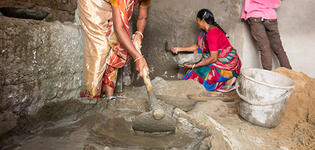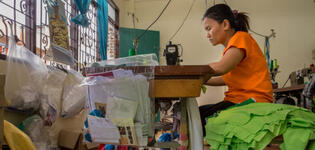Blog
Does access to microfinance help or hinder women’s empowerment?
Almost everywhere, women are underrepresented in labour markets compared to men. While labour force participation among women of working age (FLFP) has increased in recent decades, the vast majority of women in South Asia remain out of the labour market.
Traditional roles and gender norms still govern the lives of women, often discouraging women from working outside the traditional spheres of home-based production and care-related activities. Economic development often boosts women’s labour market participation by reducing the time-cost of unpaid care work and labour market discrimination, or by increasing the supply of jobs for women. However, unequal access to market opportunities can limit women's work participation even in a rapidly modernizing economy.
In countries with restrictive gender norms, self-employment in a home setting is a more socially acceptable form of economic engagement. However, with less access to financial resources, it is often more difficult for women to set up businesses. This is one reason that SDG-5 (the gender equality goal) emphasizes financial inclusion alongside other improvements.
Women dominate in microenterprises
Today, most microenterprises in developing countries are run by women. Given the high concentration of women in home-based businesses, access to microfinance loans can play an instrumental role in facilitating women's overall engagement in economic activity and entrepreneurship.
A case in point is Bangladesh, a country that has experienced sustained macroeconomic growth over the past two decades. Since the 1980s, fertility has declined sharply and female schooling has expanded dramatically. Bangladesh has also become a global hotspot for microfinance institutions (MFIs) and women's access to credit —once limited— has reached a saturation point. Female LFP has also improved, although the increase is less dramatic than changes in education and demographic indicators. Women still face social restrictions when it comes to outside mobility and are frequently victims of domestic violence. There is also significant patriarchal hold on valuable household assets.
In this context, how has access to microfinance helped?
Studying the link between credit and female employment is complicated by the fact that women with progressive outlooks and entrepreneurial skills are also more likely to join microfinance schemes. Female entrepreneurs also face additional (non-credit related) constraints and the exact use of the borrowed funds may not be limited to the participating women. Moreover, the impact is likely to differ depending on the nature of work participation and socio-emotional wellbeing of credit recipients. For these reasons, not only is the effect of microfinance theoretically ambiguous, existing studies which employ randomized control trials also report mixed evidence.
In a recently published WIDER Working Paper, we revisit some of these issues using purposefully collected data from Bangladesh — the 2014 Women’s Life Choices and Attitudes Survey (WiLCAS). We examine the effect on labour market and social outcomes and psychosocial wellbeing. For each outcome, we model the effect of access to microfinance by combining data on MFI branch locations of major MFIs in the country with household survey data. In our methodological approach, we compare outcome data on women living within and outside the catchment area of an MFI branch office.
We find that access to credit increases labour force participation in terms of paid employment and traditional economic participation. This is also consistent with the finding of a positive, albeit insignificant, effect on self-employment.
At the same time, we do not see any effect on the monthly income of women. And those with access to credit are more likely to be prevented from working by their husbands or other household members. They are also more likely to express traditional beliefs in relation to gender, social, and employment norms. Although the direction of causality here is not clear.
Moreover, we find systematically negative and significant effects of access to credit on four dimensions of subjective wellbeing: life satisfaction, financial satisfaction, health satisfaction, and overall happiness. This could reflect a rise in intra-household conflict resulting from male insecurity over a women’s control of income and productive assets, a phenomenon that the previous literature has documented in the context of female microcredit borrowers in Bangladesh. The finding also echoes earlier qualitative findings of a negative impact on the psychosocial wellbeing of female credit recipients in Bangladesh.
Microfinance still remains a popular movement to improve women’s economic wellbeing. Irrespective of the employment and labour outcomes of interest, women’s access to credit is viewed by many as a basic human right.
How should our findings be interpreted for policy purposes?
For policy-makers, our findings highlight the challenges of increasing women’s economic participation through improved access to credit. Furthermore, greater work participation among women through improved access to credit may not necessarily translate into positive changes in social norms. We argue that, for credit-based interventions to have a transformative effect on women’s economic participation, they need to be complemented by other policies to support women, including more secure access to productive assets and legal protection against domestic violence.
The views expressed in this piece are those of the author(s), and do not necessarily reflect the views of the Institute or the United Nations University, nor the programme/project donors.
 Join the network
Join the network











